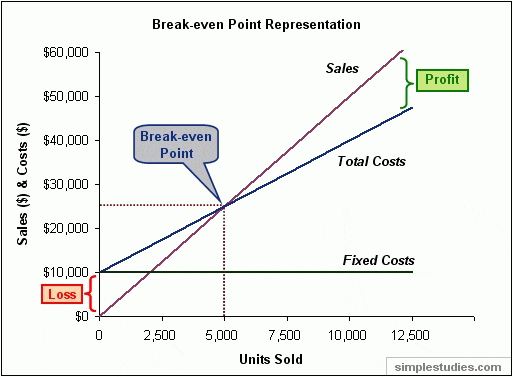


Contributions Margin is the “selling price less the variable costs per unit”, the denominator in the equation above. This can be computed under a range of sale prices with the formula below.Ī key concept of this formula is the Contributions Margin.
#BREAK EVEN POINT IN DOLLARS SERIES#
One approach is to pick a sale price or a series of sale prices and compute how much of the product you will need to sell at each price to break even.īreakeven sales volume is the amount of your product that you will need to produce and sell to cover total costs of production. To do this you need to classify the costs into the managerial cost categories of variable and fixed costs. Because fixed costs need to be covered regardless of the number of units produced and sold, the number of units you produce and sell determines the price needed to break even. However, there is not a specific price level that you can charge that will assure you that you will cover your costs. Sales).Product price can be based on the cost of producing the product. Variable costs are $25 perĬontribution margin is $100 ($125 sales – $25 variable) and theĬontribution margin ratio is 80% ($100 contribution margin /$125 Variable costs include snacks andīeverages provided to passengers, baggage handling costs, and theĬost of the additional fuel required to fly the plane with Salaries of required crew members, gate attendants, and maintenanceĪnd refueling personnel. Its destination depreciation on the plane used on the flight and The fuel required to fly the plane and crew (with no passengers) to Same regardless of the number of seats filled. Management must identify and separate costs into fixed and variable Sold on Flight 529 to make $8,000 in profit. Management of a major airline wishes to know how many seats must be If you think about it, it IS the sameįormula because at break even our target income is ZERO.Ī YouTube element has been excluded from this The same formulas we used for break even analysis but this time we The good news is you haveĪlready learned the basic formula, we are just changing it You can also use this same type of analysis toĭetermine how many sales units or sales dollars you would need to

Percent before the company would incur a loss. This means that sales volume could drop by 16.67 Using the data just presented, we compute the Sometimes people express the margin of safety asĪ percentage, called the margin of safety rate or just margin of For example, assume Video Productions currently has sales of The amount by which sales can decrease before the company incurs a If a company’s current sales are more than itsīreak-even point, it has a margin of safety equal to current sales Variable costs equal sales revenue, as shown here: The break-even volume of sales is $ 100,000 (canĪlso be calculated as break even point in units 5,000 units x sales That is, for each dollar of sales, there is a $Ġ.40 left over after variable costs to contribute to covering fixedĬalculate Video Production’s break-even point in sales dollars Revenues of $ 120,000, we compute the contribution margin ratio asĬontribution margin $48,000 / Revenues $120,000 = 0.40 or 40%. Video Productions had a total contribution margin of $48,000 on Or, referring to the income statement in which Production’s contribution margin ratio is: Contribution Margin Ratio = Per unit, or total contribution margin by total revenues. Ratio, divide the contribution margin per unit by the selling price The contribution margin ratio expresses theĬontribution margin as a percentage of sales. Sales dollars looks a lot like the formula to compute theīreak-even in units, except we divide fixed costs by the The formula to compute the break-even point in Small components, it makes no sense to think of a break-even point For a company such as GM that makes Cadillacs and certain \)Ĭompanies frequently think of volume in sales dollars instead of


 0 kommentar(er)
0 kommentar(er)
